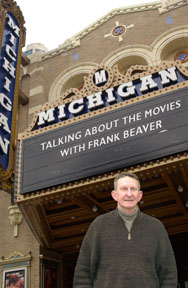September 2005
Talking About the Movies: Susan Sontag’s On Photography
By Frank Beaver
One of three must-read works for serious lovers of the cinema
Editor’s Note: A computer glitch caused us to insert a BBC obituary of Susan Sontag into Frank Beaver’s Talking About the Movies column in our August 2005 issue, rather than his piece. We have replaced the August column with the proper piece, which also appears in this issue, so all readers will have a chance to read it. We apologize for any confusion the error may have caused.
On the occasion of Susan Sontag’s death last December much was written about her literary career as one of the country’s most brilliant and provocative intellects.
Sontag wrote novels, essays, film reviews and even a couple of screenplays. A series of her essays, first published in the New York Review of Books, was collected in 1977 into a manuscript titled On Photography. It earned the National Book Award for criticism, wound up on best-seller lists and is now considered a classic study of the ethical, cultural and aesthetic implications of photography. While its focus is on still photography, Sontag’s book is one of three works that I have deemed essential reading for students and cineastes interested in film theory. The other two classics are Rudolf Arnheim’s Film as Art and Siegfried Kracauer’s Theory of Film. The substance and value of these theoretical writings will be discussed in a three-part series beginning with this column on Susan Sontag’s On Photography.
Sontag’s six essays constitute a deep and serious examination of the impact of still photographs on our lives, and of the very act of taking photographs—both by professionals and amateurs. In the opening essay she builds a provocative case for the significant role of family photos and the photographic album. Sontag argues that: “Through photographs, each family constructs a portrait chronicle of itself—a portable kit of images that bears witness to its connectedness…. A family’s photographic album is generally about the extended family—and is often all that remains of it.”
Sontag carefully draws distinctions between still photographs and photographic images in moving pictures, favoring individual photographs that can be held in one’s hand and studied at length for their personal-archival value. Photographs on film or in books, she says, “cease to be collectibles…. Each still photograph is a privileged moment, turned into a slim object that one can keep and look at again.”
And yet, On Photography is rich in allusions to films that incorporate photography as a significant part of the narrative: Vertov’s Man With a Movie Camera (1926),
Cocteau’s Les Enfants Terrible (1949), Hitchcock’s Rear Window (1954), Powell’s Peeping Tom (1960); Godard’s Les Carabiners (1963), Marker’s La Jetee (1963) and Antonioni’s Blow Up (1966). Each of these films reveals ways that various photographers function or ways that filmmakers have used photographs as correlative objects for defining screen characters’ inner lives.
Sontag’s ruminations on photography include discussions of how the pervasiveness of photographic images has made all the world “an object of appraisal,” and thereby has conditioned our sense of the world. In a particularly acute commentary on the photographer’s penchant for cataloguing “misery and injustice throughout the world,” Sontag argues that repeated exposure to such images may in fact have “anesthetized” us to them—when one might otherwise have expected a strengthening of “conscience” and compassion.
In her far-reaching analyses Sontag explores the darker side of photography by treating at length the work of Diane Arbus and her self-described “naughty” images of ordinary and unordinary people. Other essays offer incisive accounts of the avant-garde and surrealist impulses in photography, of scientist photographers and of photographers who have “aggrandized” about the art and function of photography through their personal views of the medium’s aesthetic and stylistic possibilities, for example Moholy-Nagy, Cartier-Bresson, Abbott, Stieglitz, Weston, Adams.
On Photography ends with a McLuhanesque inquiry into the role of photographic images in determining “realities,” with the provocative claim that an image-world might in fact be replacing the real one.
Sontag’s critical commentaries are as stimulating and timely today as they were 30 years ago, and so are Rudolf Arnheim’s collection of essays published in 1957 in Film as Art. Sontag and Arnheim (who joined Michigan’s faculty after retiring from Harvard’s and still lives in Ann Arbor) both maintained that although photography and film retrieve their images mechanically from a “real world,” they are nonetheless objects of art.
Arnheim’s views on that subject will be the topic of next month’s Talking About the Movies.

Film historian and critic Frank Beaver is professor of film and video studies and professor of communication.
|


